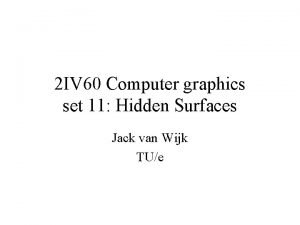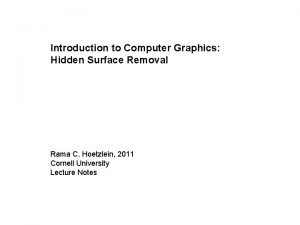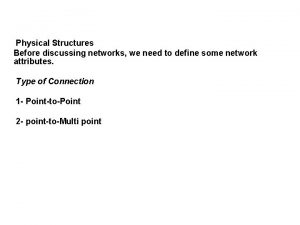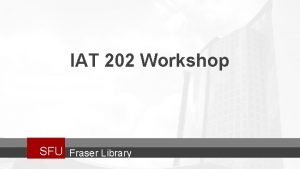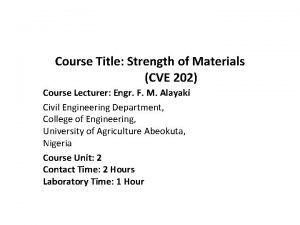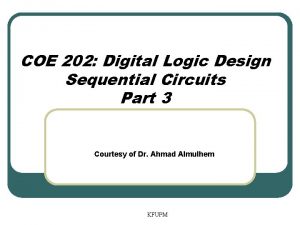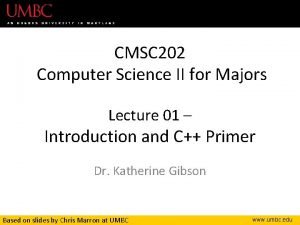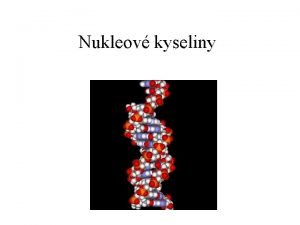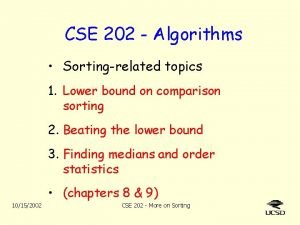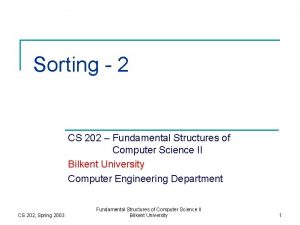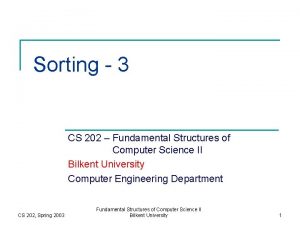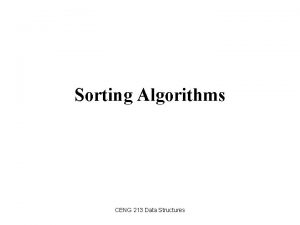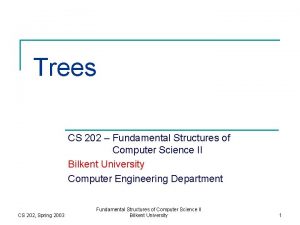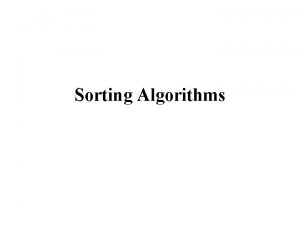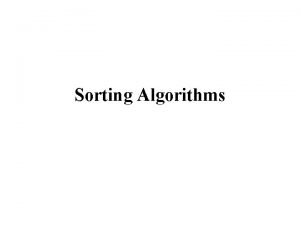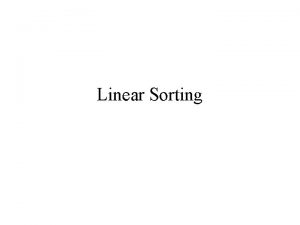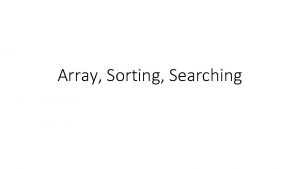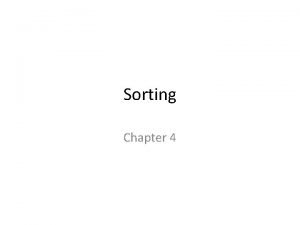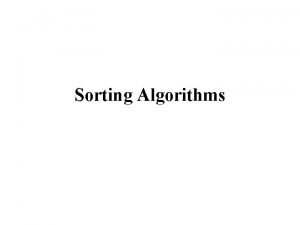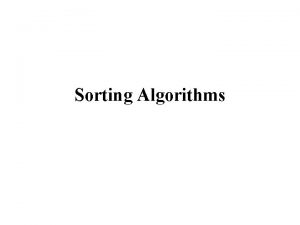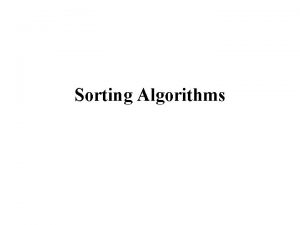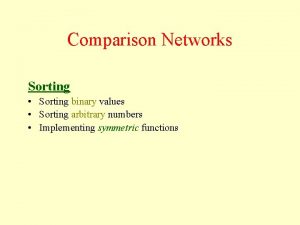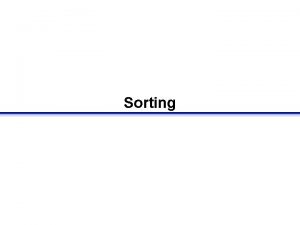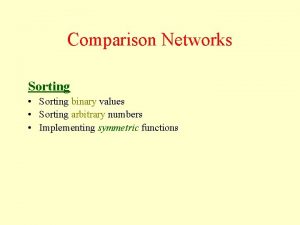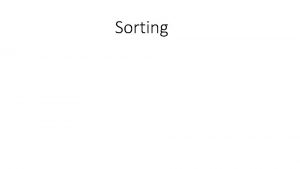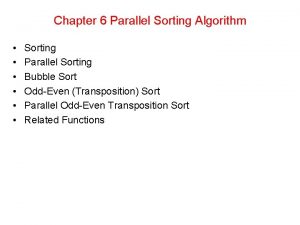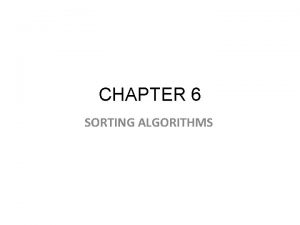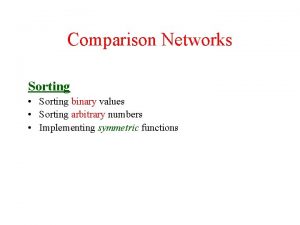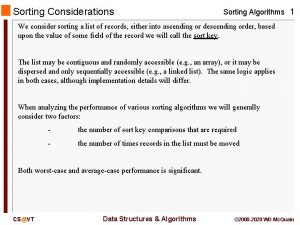Sorting CS 202 Fundamental Structures of Computer Science





























- Slides: 29

Sorting CS 202 – Fundamental Structures of Computer Science II Bilkent University Computer Engineering Department CS 202, Spring 2003 Fundamental Structures of Computer Science II Bilkent University 1

Sorting n n Sorting is ordering a set of elements in increasing or decreasing order. We will assume that q q q Elements are comparable They are kept in an array Each cell of the array keep one element For simplicity the elements are integers. But the same methods are valid for any type of element that can be ordered. We will express the number of element to be sorted as N. CS 202, Spring 2003 Fundamental Structures of Computer Science II Bilkent University 2

Sorting n There are various sorting algorithms q Easy algorithms: O(N 2) running time n q Very easy to implement ones: o(N 2) n q Efficient in practice More complicated ones n n n Insertion sort, etc. Running time of O(Nlog. N) Such as Quick Sort, Merge Sort, etc. A general purpose sorting algorithm requires Ω(Nlog. N) comparisons. CS 202, Spring 2003 Fundamental Structures of Computer Science II Bilkent University 3

Sorting n The data to be sorted can fit in memory; q n We will first see the algorithms for this case. The data can also be residing in disk and algorithm can be run over disk q This is called external sorting. CS 202, Spring 2003 Fundamental Structures of Computer Science II Bilkent University 4

Insertion Sort n n n A simple algorithm Requires N-1 passes over the array to be sorted (of size N). For passes p=1 to N q Ensures that the elements in positions 0 through p are in sorted order. CS 202, Spring 2003 Fundamental Structures of Computer Science II Bilkent University 5

Example 34 8 64 51 32 21 Array to be sorted. N=6 CS 202, Spring 2003 Fundamental Structures of Computer Science II Bilkent University 6

Pass 1 Compare 34 8 64 51 32 21 8 Current Item 34 64 51 32 21 move 8 insert CS 202, Spring 2003 Fundamental Structures of Computer Science II Bilkent University 7

Pass 2 compare 8 34 64 51 32 21 64 Current Item CS 202, Spring 2003 Fundamental Structures of Computer Science II Bilkent University 8

Pass 3 compare 8 34 64 51 32 21 Current Item compare 8 51 34 64 32 21 move 8 34 51 insert CS 202, Spring 2003 Fundamental Structures of Computer Science II Bilkent University 9

Pass 4 compare 8 51 34 64 32 21 Current Item compare 8 34 51 64 21 move compare 8 32 34 move compare 8 move 8 32 insert CS 202, Spring 2003 Fundamental Structures of Computer Science II Bilkent University 10

Pass 5 compare 8 34 32 51 64 21 Current Item compare 8 34 32 51 64 move compare 8 32 34 51 64 move compare 8 21 32 move compare 8 move 8 CS 202, Spring 2003 21 Fundamental Structures of Computer Science II Bilkent University RESULT!! 11

Pseudo-Code void insertion. Sort(vector<int> &a) { int j; test } for ( int p = 1; p < a. size(); ++p ) { int tmp = a[p]; for (j=p; j > 0 && tmp < a[j-1]; j--) /* compare */ a[j] = a[j-1]; /*move */ a[j] = tmp; /* insert */ } CS 202, Spring 2003 Fundamental Structures of Computer Science II Bilkent University 12

Analysis of Insertion Sort n The test the line shown in the previous slide is done at most: q p+1 times for each value of p. CS 202, Spring 2003 Fundamental Structures of Computer Science II Bilkent University 13

Lower bound for simple sorting algorithms n Simple sorting algorithms are the ones that make swaps of adjacent items. q q q n Insertion sort Bubble sort Selection sort Inversion definition: q An inversion in an array of numbers is any ordered pair (i, j) having the property that i < j but a[i] > a[j] CS 202, Spring 2003 Fundamental Structures of Computer Science II Bilkent University 14

Inversion n Example: q q Array items: 34 8 64 51 32 21 Inversions: n n q q q (34, 8), (34, 32), (34, 21), (64, 51), (64, 32), (64, 21), (51, 32), (51, 21), and (32, 21). We have total of 9 inversions. Each inversion requires a swap in insertion sort to order the list. A sorted array has no inversions. Running time = O(I + N), where I is number of inversions. CS 202, Spring 2003 Fundamental Structures of Computer Science II Bilkent University 15

Inversion n Compute the average number of inversions in an array. q q n Assume no duplicates in the array (or list). Assume there are N elements in range [1, N]. Then input to the sorting algorithms is a permutation of these N distinct elements. CS 202, Spring 2003 Fundamental Structures of Computer Science II Bilkent University 16

Theorem n n Theorem: The average number of inversions in an array of N distinct elements is N(N-1)/4. Proof: q For any list of items, L, consider the list in reverse order Lr. n n q q L = 34 8 64 51 32 21 Lr = 21 32 51 64 8 34 Consider any pair (x, y) in list L, with x < y. The pair (x, y) is certainly an inversion in one of the lists L and Lr CS 202, Spring 2003 Fundamental Structures of Computer Science II Bilkent University 17

Theorem n Proof continued q q The total number of these pairs (which are inversions) in a list L and its reverse Lr is N(N-1)/2. Therefore, an average list L has half of this amount, which is N(N-1)/4. CS 202, Spring 2003 Fundamental Structures of Computer Science II Bilkent University 18

Shell Sort n n n Invented by Donald Shell. Also referred to as diminishing increment sort. Shell sort uses a sequence h 1, h 2, …, ht, called the increment sequence. q q h 1 must be 1. Any sequence will do. CS 202, Spring 2003 Fundamental Structures of Computer Science II Bilkent University 19

Shell Sort n It is executed in phase. q n After a phase where increment were hk q q q n One phase for each hk For every i, a[i] <= a[i+hk]. This means all elements spaced hk apart are sorted. The input is then said to be hk sorted. An hk sorted input, which is then hk-1 sorted, is still hk sorted. CS 202, Spring 2003 Fundamental Structures of Computer Science II Bilkent University 20

Shell Sort Original List 81 94 11 96 12 35 17 95 28 58 41 75 15 After 5 -sort 37 17 11 28 12 41 75 15 96 58 81 94 95 After 3 -sort 28 12 11 35 15 41 58 17 94 75 81 96 95 After 1 -sort 11 12 15 17 28 35 41 58 75 81 94 95 96 CS 202, Spring 2003 Fundamental Structures of Computer Science II Bilkent University 21

Shellsort Algorithm void shellsort (vector<int> &a) { int j, i; int gap; } for (gap = a. size() /2; gap > 0; gap /=2) { for (i=gap; i < a. size(); i++) { int tmp = a[i]; for (j=i; j>=gap && tmp < a[j-gap]; j -= gap) a[j] = a[j-gap]; a[j] = tmp; } } CS 202, Spring 2003 Fundamental Structures of Computer Science II Bilkent University 22

Choosing Increment Sequence Suggested by Donald Shell N: the number of items to sort. CS 202, Spring 2003 Fundamental Structures of Computer Science II Bilkent University 23

Worst Case Analysis of Shell Sort n Theorem: q n The worst case running time of Shell sort using Shell’s increments is Θ(N 2). . q q We will show a lower bound for the running time. We will also show an upper bound for the running time. CS 202, Spring 2003 Fundamental Structures of Computer Science II Bilkent University 24

Lower bound n We will show that there exists an input that causes the algorithm to run in Ω(N 2) time. q q q Assume N is power of 2. Assume these N elements is stored in an array indexed from 1 to N. Assume that n n n odd index values contain the N/2 largest elements and even index values contain the N/2 smallest element. 1, 9, 2, 10, 3, 11, 4, 12, 5, 13, 6, 14, 7, 15, 8, 16 is such as sequence. CS 202, Spring 2003 Fundamental Structures of Computer Science II Bilkent University 25

Lower bound n Shell’s increments are: q n n All increments except the last one are even. When we come to the last pass, q q n 1, 2, 3, …. , N/2 all largest items are in even positions and all smallest items are in odd positions. Snapshot before last pass q 1, 9, 2, 10, 3, 11, 4, 12, 5, 13, 6, 14, 7, 15, 8, 16 CS 202, Spring 2003 Fundamental Structures of Computer Science II Bilkent University 26

Lower bound n n The ith smallest number is at position 2 i-1 before the last pass. Restoring the ith element to its correct position requires: q n 2 i-1 -i = i-1 moves towards the beginning of the array (each move make the item go one cell left). Therefore to place N/2 smallest elements to their correct positions require amount of work in the order: CS 202, Spring 2003 Fundamental Structures of Computer Science II Bilkent University 27

Upper Bound n A pass with increment hk consists of hk insertion sorts of about N/hk helements = 3, N = 16 k 1 9 2 10 3 11 4 12 5 6 14 7 15 8 16 Insertion sort of 16/3 ~= 5 items, items are = 1, 10, 4, 6, 15 Insertion sort of 16/3 ~= 5 items, items are = 9, 3, 12, 14, 8 Insertion sort of 16/3 ~= 5 items hk * (N/hk)2 CS 202, Spring 2003 Fundamental Structures of Computer Science II Bilkent University 28

Upper Bound n Summing over all passed CS 202, Spring 2003 Fundamental Structures of Computer Science II Bilkent University 29
 Internal vs external sorting
Internal vs external sorting Depth sorting algorithm
Depth sorting algorithm Depth sorting method in computer graphics
Depth sorting method in computer graphics What s your favorite subject
What s your favorite subject Homology
Homology What is the first fundamental principle of fingerprints
What is the first fundamental principle of fingerprints Architecture is art and science
Architecture is art and science Physical structures in computer networks
Physical structures in computer networks Example of interrupt in os
Example of interrupt in os Revised bp form 202
Revised bp form 202 Elastic energy
Elastic energy Cs202 iitk
Cs202 iitk Mt760 swift message format 2021
Mt760 swift message format 2021 Linia kolejowa 202
Linia kolejowa 202 Mt 202
Mt 202 202 accepted
202 accepted Iat 202
Iat 202 Cve 202
Cve 202 Coe202
Coe202 Pos expression can be implemented using
Pos expression can be implemented using Consensus theorem
Consensus theorem Cmsc 202
Cmsc 202 Xxxxxzxx
Xxxxxzxx Cvsp aub
Cvsp aub Ashrae standard 202 pdf
Ashrae standard 202 pdf Esterova vazba
Esterova vazba Cse 202
Cse 202 Cse 202
Cse 202 Cpcs 202
Cpcs 202 Coe 202
Coe 202

